Taxonomy: Class: Mammalia; Order: Lagomorpha; Family: Leporidae
Description
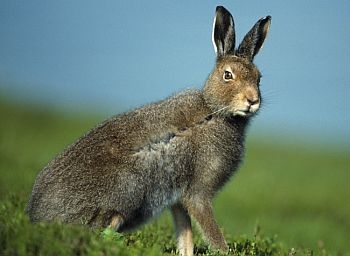
Mountain hare © Laurie Campbell
Also known as the blue hare, this herbivorous animal is native to Britain and Ireland. Unlike other European lagomorphs, its coat changes from brown in summer to white in winter. It is distinguished from brown hare by its tail, which is white throughout the year, whereas brown hare has a tail with a black upperside. In Britain, the mountain hare is restricted to upland areas, but in Ireland it is found at all elevations. At high densities it can damage agricultural crops and young forestry.
In England and Wales, the mountain hare can be shot throughout the year on enclosed land, while on moorland or unenclosed non-arable land, it can be shot between 11 December and 31 March. In Scotland, since 2011, the mountain hare can be shot between 1 August and 29 February. In Northern Ireland, it can be shot between 12 August and 31 January.
Further information:
Mammal Society website mountain hare page.
Conservation status and legislation
Status:
UK: Native. Priority species under the UK Biodoversity Action Plan
World: Least Concern (IUCN Red List)
Legislation:
Distribution and abundance
In Great Britain, the mountain hare is found mainly in mainland Scotland, although it has also been introduced to Shetland, Hoy, Lewis, Harris, Skye, Raasay, Scalpay, Jura and the Isle of Man. Small numbers are also found in the Derbyshire Peak District, and there have been introduction attempts elsewhere in England and Wales. It is found throughout Ireland, although a scarcity of records means that this is not apparent from the map.
Estimates of mountain hare abundance (numbers of individuals in the spring) across the UK, from Harris et al. (1995):
Recent trends from the National Gamebag Census
United Kingdom
Index of bag density from 1961 to 2009 (see statistical methods and interpretational considerations).
Error bars represent 95% confidence intervals.
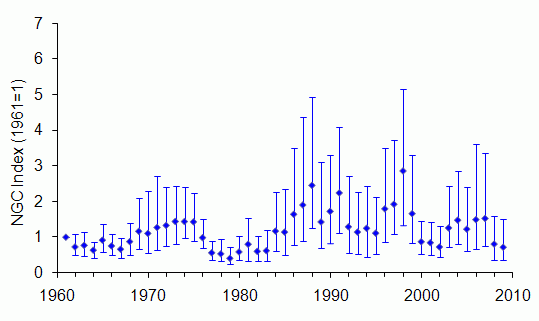
A cyclic trend in the index of bag density is apparent between 1961 and 2009, with increases from 1967 to 1974, 1983 to 1988, 1995 to 1998, and 2002 to 2007 alternating with periods of low bags. The two most recent years 2008 and 2009 correspond to such a trough. Overall, there are no significant long-term trends. The reason for the cycles is unknown, but possible causes are parasitic infection, nutrition and predation.
Change in mountain hare bags over time, with 95% confidence limits (see statistical methods):
| Country |
Sites |
Start
year |
End
year |
Change (%)
1961-2009 |
Change (%)
1984-2009 |
Change (%)
1995-2009 |
| United Kingdom |
194 |
1961 |
2009 |
27
-41 to 200 |
-16
-57 to 42 |
-40
-68 to 20 |
* significant at P < 0.05
England
There are too few bag records of mountain hare to produce an index graph. 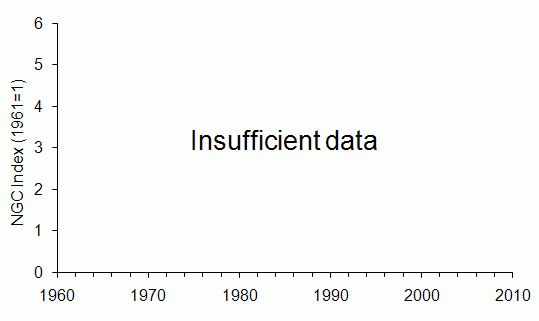
There are too few bag records of mountain hare to evaluate rates of change over time
| Country |
Sites |
Start
year |
End
year |
Change (%)
1961-2009 |
Change (%)
1984-2009 |
Change (%)
1995-2009 |
| England |
Too few sites |
Scotland
Index of bag density from 1961 to 2009 (see statistical methods and interpretational considerations).
Error bars represent 95% confidence intervals.
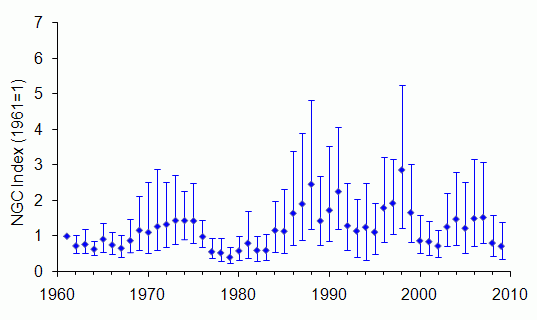
A cyclic trend in the index of bag density between 1961 and 2009, with increases from 1967 to 1974, 1983 to 1988, 1995 to 1998, and 2002 to 2007 alternating with poor seasons. 2008 and 2009 were trough years. Overall, there were no significant long-term trends. The reason for the cycles is unknown, but possible causes are parasitic infection, nutrition and predation.
Change in mountain hare bags over time, with 95% confidence limits (see statistical methods):
| Country |
Sites |
Start
year |
End
year |
Change (%)
1961-2009 |
Change (%)
1984-2009 |
Change (%)
1995-2009 |
| Scotland |
187 |
1961 |
2009 |
27
-39 to 173 |
-16
-58 to 73 |
-40
-70 to 22 |
* significant at P < 0.05
Wales
There are too few bag records of mountain hare to produce an index graph. 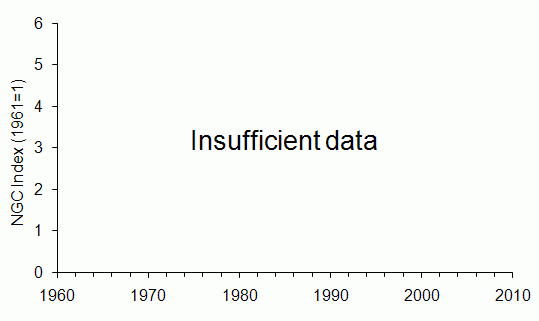
There are too few bag records of mountain hare to evaluate rates of change over time
| Country |
Sites |
Start
year |
End
year |
Change (%)
1961-2009 |
Change (%)
1984-2009 |
Change (%)
1995-2009 |
| Wales |
Too few sites |
N Ireland
There are too few bag records of mountain hare to produce an index graph. 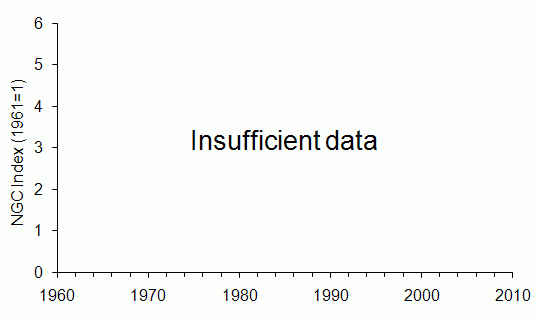
There are too few bag records of mountain hare to evaluate rates of change over time
| Country |
Sites |
Start
year |
End
year |
Change (%)
1961-2009 |
Change (%)
1984-2009 |
Change (%)
1995-2009 |
| N Ireland |
Too few sites |
Environmental zones
Change in mountain hare bags over time, with 95% confidence limits (see statistical methods):
| Environmental zone |
Sites |
Start
year |
End
year |
Change (%)
1961-2009 |
Change (%)
1984-2009 |
Change (%)
1995-2009 |
| Easterly lowlands (England/Wales) |
Too few sites |
| Westerly lowlands (England/Wales) |
Too few sites |
| Uplands (England/Wales) |
Too few sites |
| Lowlands (Scotland) |
25 |
1961 |
2009 |
-80
-92 to 463 |
-26
-43 to 1968 |
35
-8 to 1134 |
| Intermediate uplands/islands (Scotland) |
24 |
1961 |
2009 |
115
-79 to 4884 |
87
-55 to 129 |
59
-45 to 111 |
| True uplands (Scotland) |
138 |
1961 |
2009 |
29
-50 to 223 |
-23
-72 to 57 |
-47
-80 to 5 |
* significant at P < 0.05
Comparison with BBS mammal data
Since 1995, data on mountain hare abundance have been collected under the Breeding Bird Survey (BBS) organised by the British Trust for Ornithology. Below, the UK trend from the NGC is compared to the one from the BBS (from 1995 onwards).
NGC index of bag density (blue) and BBS index of abundance (red), from 1995 to 2009.
Error bars represent 95% confidence intervals.
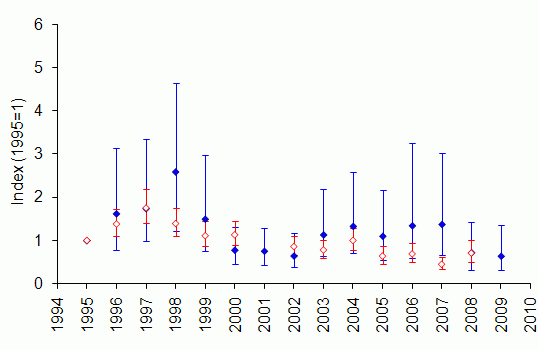
The BBS and the NGC reported a similar cyclic and declining trend between 1995 and 2009 across Scotland, although the second cycle was more pronounced in the bags than in the counts. As a result, all confidence limits are widely overlapping except for those in 2007.
Long-term trend from the National Gamebag Census
Index of bag density from 1901 to 2009 (see statistical methods and interpretational considerations).
Error bars represent 95% confidence intervals.
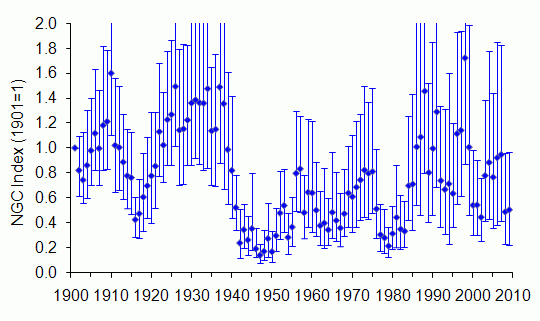
A long-term cyclic trend is apparent in the index of bag density in the UK between 1901 and 2009, with increases from 1904 to 1910, 1917 to 1926, 1951 to 1959, 1967 to 1974, 1983 to 1988, 1995 to 1998 and 2002 to 2007, alternating with periods of low bags. Bags over the last 25 years are remarkably similar to those in first 25 years of the 1900s. The reason for the cycles is unknown, but possible causes are parasitic infection, nutrition and predation.
References and further reading
- Battersby,J. (2005). UK Mammals: Species Status and Population Trends. Joint Nature Conservation Committee/Tracking Mammals Partnership, Peterborough (JNCC download page).
- Flux,J.E.C. (1970). Life history of the mountain hare (Lepus timidus scoticus) in north-east Scotland. J. Zoology Lond. 161: 75-123.
- Harris,S., Morris,P., Wray,S. & Yalden,D.W. (1995). A Review of British Mammals: Population Estimates and Conservation Status of British Mammals Other than Cetaceans. Joint Nature Conservation Committee, Peterborough (JNCC download page).
- Harris,S. & Yalden,D.W. (2008). Mammals of the British Isles: Handbook, 4th edition. Mammal Society, Southampton.
- Patton,V., Ewald,J.A., Smith,A.A., Newey,S., Iason,G.R. & Thirgood,S.J. (2010). Distribution of mountain hares Lepus timidus in Scotland: results from a questionnaire. Mammal Review 40: 313-326.
This report should be cited as: Aebischer,N.J., Davey,P.D. & Kingdon,N.G. (2011). National Gamebag Census: Mammal Trends to 2009. Game & Wildlife Conservation Trust, Fordingbridge (http://www.gwct.org.uk/ngcmammals).
Return to species list